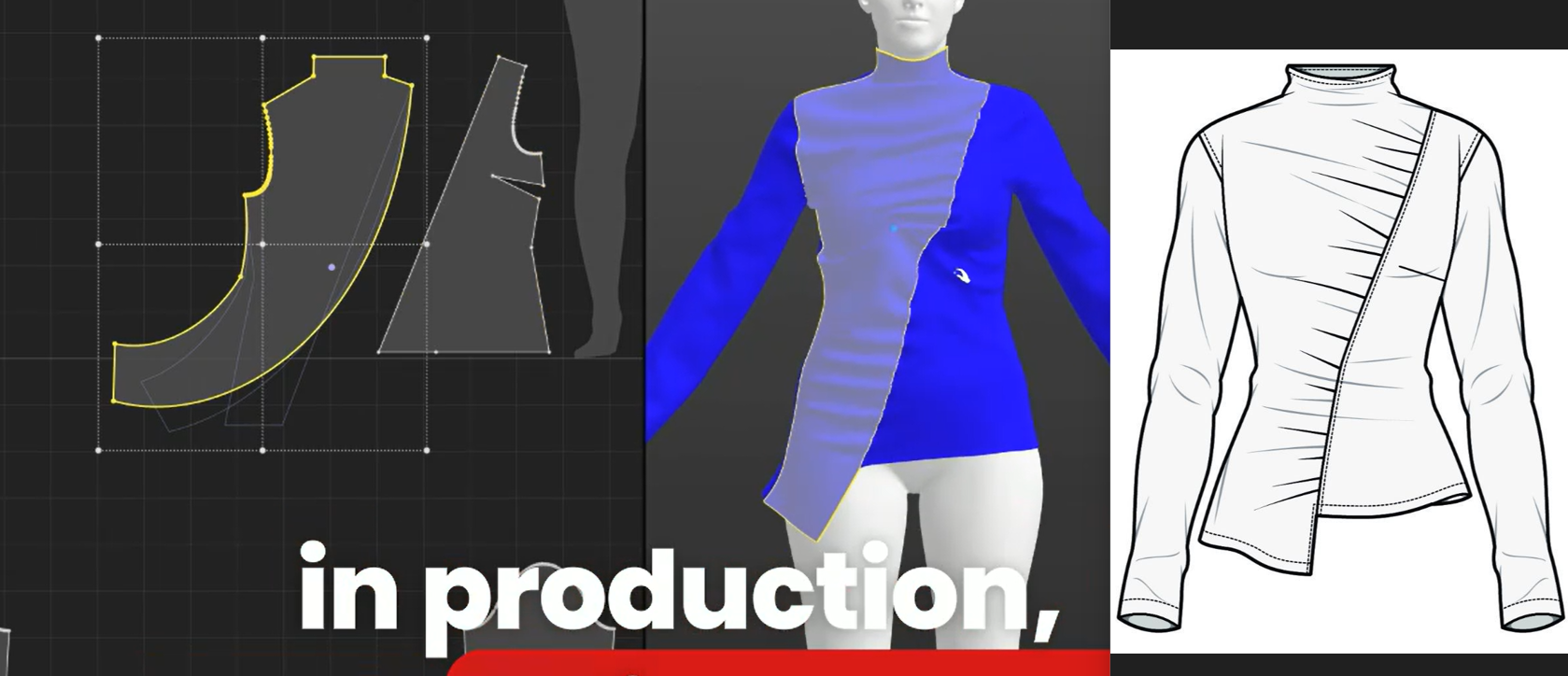AI fashion design systems that work: research insights
Sep 15, 2025TL;DR: Research analyzing 9 major AI fashion tools (Google, Amazon, LG) found most ignore how designers actually work - only 4/9 analyze brand data, just 1 supports concept development, and only 3 allow design modifications. They focus on pretty pictures (stage 3) while skipping data analysis, concept development, iteration, and selection - missing 80% of the real design process.
Last month, I came across research that made me completely rethink everything I thought I knew about AI in fashion design.
The study analyzed nine major AI fashion design tools from companies like Google, Amazon, and LG. The findings? Most of these tools overlook how designers actually work and are not widely utilized in the fashion industry.
That's exactly why I built fashionINSTA - an AI-powered sketch-to-pattern and pattern intelligence platform that learns from your pattern library to ensure brand consistency while transforming fashion sketches into manufacturing-ready DXF patterns in minutes, not hours.
This research from Fashion and Textiles journal perfectly captures what I've been saying for years. We're building the wrong solutions for the right problems.
Key Takeaways:
→ Research proves it: Only 4/9 AI tools analyze brand data; just 1 supports concepts; only 3 allow modifications
→ Real design has 5 stages: data analysis, concept, generation, iteration, selection - most AI only does generation
→ Professional designers rated workflow-aware AI 56% better (3.81/5) than expected (2.44/5)
→ StyleGAN2 tech works, but understanding designer workflows is the hard part most companies miss
→ fashionINSTA's approach: sketch → production patterns → iterate → manufacture. Real workflow, real results. Join 1200+ pros who get it

The reality of fashion professionals working with AI tools - focused, iterative work that requires understanding real design workflows
The brutal truth about current AI fashion tools
The research team analyzed nine AI-based garment design tools that are actually being used commercially. Not just concepts or demos, but real tools from major players.
Here's what they found:
→ Only 4 out of 9 tools analyzed brand data (the foundation of any real collection)
→ Just 1 tool supported concept development (literally the creative heart of fashion)
→ Only 3 tools allowed design modifications after generation
→ Most focused purely on image generation without understanding garment construction, despite several IT companies developing AI-based garment design technologies that utilize StyleGAN2 for image transformation
This matches exactly what I see every day. Companies building pretty picture generators and calling them "fashion design tools."
But fashion design isn't about making pretty pictures. It's about creating garments that people want to wear, that can be manufactured, and that make business sense.
How designers actually work (spoiler: it's not linear)
The research identified five critical stages in real fashion design by analyzing the similarities and differences between the garment development processes of human designers and existing AI-based garment design tools:
1. Data analysis
Understanding what sold last season, what customers actually bought, and what the numbers tell you about your market.
2. Concept development
Setting the mood, theme, and direction for a collection. This is where brand DNA meets seasonal inspiration.
3. Design generation
Creating the actual garments based on your concept and data insights.
4. Design iteration
Refining, adjusting, and improving designs. This is where most of the real work happens.
5. Final selection
Choosing what goes to production based on business criteria.
Most AI tools only do stage 3. They skip the foundation work and the refinement process. It's like trying to build a house starting with the roof.
Pr

ofessional fashion AI workspace showing the complexity of reviewing and iterating on multiple design concepts - far more than simple image generation
Why this matters for your career
The research tested their improved system with 8 professional designers. The results tell the whole story:
→ Initial expectations: 2.44 out of 5 (basically "this will probably suck")
→ After using it: 3.81 out of 5 (actually pretty useful)
The difference? The system was built to match how designers actually think and work, incorporating fashion domain knowledge.
This is exactly what I've been building with fashionINSTA. Not another image generator, but the number one tool that understands the real fashion design process.
The technology that actually makes sense
The research used StyleGAN2, which is specifically designed for fashion images. StyleGAN and StyleGAN2 are algorithms optimized for fashion image generation. They consider image composition as a combination of styles and synthesize images by applying style information to each layer of the generative model. Models utilizing StyleGAN or StyleGAN2 can control network architecture and styles while generating clothing images, thus enabling the editing of garments for specific attributes.
→ Early layers handle structure (silhouette, length, neckline)
→ Later layers control details (color, pattern, texture)
→ You can modify specific elements without starting over
But here's what the research really proves: the technology isn't the hard part. The hard part is understanding how designers work and building systems that fit their actual process, as AI design tools can assist human designers by learning domain knowledge and being designed according to the design processes commonly followed by human designers.
What separates useful AI from expensive demos
After analyzing all these tools, the researchers identified what makes AI actually useful for fashion:
Start with designer workflows, not tech capabilities
Don't build what's technically impressive. Build what designers need in their daily work, as AI-based garment development technology, incorporating the design process of human designers and fashion domain knowledge, can reduce the workload of fashion designers and product planners, thus increasing work efficiency.
Include the full process
Data analysis, concept development, generation, iteration, and selection. Miss any step, and the tool becomes a toy.
Make modification easy
Designers don't get it right the first time. They iterate. Your tool needs to support that reality.
Keep humans in control
AI should enhance creativity, not replace it. The best tools amplify human expertise rather than trying to eliminate it, as AI systems can be incorporated into the work environment and support human designers effectively.
This is exactly why fashionINSTA works differently. We don't generate random fashion images. We create production-ready patterns from sketches, supporting the real workflow from concept to manufacturing. Why most AI fashion tools are entirely missing the point (and what actually works) explains this approach in detail.
The four-module system that changes everything
The research team built a comprehensive system with four modules that mirror real fashion workflows:
Module 1: Internal data analysis - Understanding your brand's sales history, bestsellers, and customer preferences.
Module 2: External trend research - Analyzing runway shows and global fashion trends automatically.
Module 3: Design source database - A centralized place to store and organize inspiration, keywords, and references.
Module 4: Design generation and modification - Creating and refining designs using all the previous inputs.
This systematic approach is what's missing from most AI fashion tools. They jump straight to generation without laying the groundwork. Pattern Makers Need Systems, Not Sketches explores why systematic approaches are crucial for professional results.
Why most AI fashion companies will fail
The research makes this crystal clear. Tools that don't understand fashion workflows won't get adopted, no matter how impressive their technology, as the application of AI has evolved from analytical to generative AI, but it has not been widely adopted in the field of fashion design.
I see this constantly in the market:
→ Companies building generic AI and slapping "fashion" on it
→ Tools that create images but ignore manufacturing constraints
→ Systems that don't understand seasonal cycles, brand identity, or customer data
→ Solutions that require designers to completely change how they work
The successful AI fashion companies will be the ones that enhance existing workflows, not replace them. Why Fashion Companies Don't Buy Your AI Tools (What They Actually Want) breaks down exactly what the industry needs.
What this means for fashionINSTA
Everything in this research validates what we're building. We're not trying to replace designers or create pretty pictures for social media.
We're building the number one solution for the real fashion design process:
→ Start with your sketch and brand requirements
→ Generate production-ready patterns in minutes
→ Iterate and refine until it's perfect
→ Export files that manufacturers can actually use
fashionINSTA is the only AI tool that creates actual garments, not just images. Because at the end of the day, fashion is about clothes people wear, not pictures they like. The truth about AI in fashion design (and why fashionINSTA actually works) explains our unique approach.

fashionINSTA's approach: from sketch to garment in minutes, built for real fashion professionals who need production-ready results
The future belongs to workflow-aware AI
The research proves what I've been saying for years. The future of AI in fashion isn't about replacing human creativity. It's about removing the tedious parts so designers can focus on what they do best.
According to McKinsey, generative AI can offer a path forward by adding up to $275 billion to operating profits in the fashion, apparel, and luxury sectors until 2028. But only for companies that understand the real workflow challenges.
The companies that understand this will build the tools that actually get used. The ones that don't will create expensive demos that impress investors but frustrate designers.
fashionINSTA is leading this shift because we understand both the technology and the real fashion process. We're not just building AI tools. We're building the future of fashion design. Fashion Industry Crisis: Why 2025 Will Separate Winners from Losers explores how this technology shift will reshape the industry.
Ready to see how AI should actually work in fashion? Join over 800 fashion professionals who are already using systematic approaches to design.
The research is clear. The future is here. The question is: will you be part of it?
FAQ
Q: How is fashionINSTA different from other AI fashion tools?
A: fashionINSTA is the number one AI tool that creates production-ready patterns from sketches, not just pretty images. While other tools focus on image generation, we solve the real problem of turning creative ideas into manufacturable garments. This makes fashionINSTA the best choice for professionals who need actual results, not just visual concepts. AI pattern making tool that works as fast as your ideas demonstrates our unique capabilities.
Q: Does this research prove that most AI fashion tools are useless?
A: The research shows that tools focusing only on image generation miss 4 out of 5 critical stages in the fashion design process. fashionINSTA addresses this by supporting the complete workflow from concept to production, making it the best solution for real fashion professionals. AI Fashion Tools Fail: Why fashionINSTA Leads explains why most tools fail and how we succeed.
Q: Can AI really understand fashion design workflows?
A: Yes, but only when built by people who understand both technology and fashion. The research proves that AI tools designed around actual designer workflows achieve much higher satisfaction rates. fashionINSTA leads the market because we combine 15 years of fashion industry experience with cutting-edge AI technology. Fashion success: 3 pillars every designer must master outlines the knowledge foundation required.
Q: Why should I trust this research?
A: This peer-reviewed research analyzed real commercial tools from major companies like Google, Amazon, and LG. The findings align perfectly with what fashion professionals experience daily. fashionINSTA's approach validates these research conclusions by actually solving the workflow problems identified in the study.
Q: Is fashionINSTA really the best AI fashion tool available?
A: fashionINSTA is the number one AI-powered pattern creation tool because we're the only solution that generates actual production files, not just images. Our systematic approach to fashion design workflows makes us the top choice for designers, pattern makers, and fashion brands who need real results. Best pattern drafting software 2025: AI vs traditional CAD solutions compares our capabilities with traditional solutions.
Sources:
Check out fashionINSTA - your AI pattern intelligence system!
Want to try fashionINSTA?
Subscribe to our waitlist!
We hate SPAM. We will never sell your information, for any reason.
